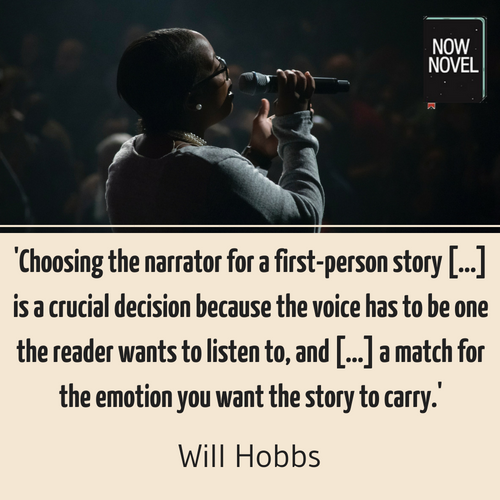First person narrative lets your main character take the reader into their confidence. The intimacy and immediacy of first person, how it closely involves your reader in your narrator’s world, makes this point of view (POV) naturally engaging. Here are 5 tips to make a good first person narrative even more lifelike:
1. Make your narrator’s language show their character
In first person, perspective is everything. Tint your narration with words that reveal your narrator’s personality, their unique perspective.
J.D. Salinger’s disaffected teen Holden Caulfield is a strong example of a characterful first person narrator. Caulfield is an icon of teenage angst in fiction. The language Salinger gives him is responsible for this, in part.
An example of Caulfield’s narration:
‘Where I want to start telling is the day I left Pencey Prep. Pencey Prep is this school that’s in Agerstown, Pennsylvania. You probably heard of it. You’ve probably seen the ads, anyway. They advertise in about a thousand magazines, always showing some hotshot guy on a horse jumping over a fence.’
Holden’s voice is clearly a cynical teenager’s. His ‘You probably heard of it’ has a world-weary ring to it. The tone is also informal (‘always showing some hotshot guy’), with a note of judgment (‘some hotshot guy’). He also uses dramatic exaggeration (‘in about a thousand magazines’).
To convey personality in first person narrative, use devices such as:
- Register: Is your narrator’s tone formal or littered with slang? How does this reflect your narrator’s age or background?
- Word choice: Mark Twain wrote ‘A man’s character may be learned from the adjectives which he habitually uses in conversation’. Does your character use positive words to describe people and places or mostly negative? What do their choices reveal?
- Sentence structure: Even sentence structure is often revealing. A character who speaks in short, simple, clipped sentences might be a salt-of-the-earth, plain-speaking type. Whereas a character who uses long run-on sentences might be more of a thinker
- Body language and gesture: Include movement or habitual gestures (e.g. running a hand through one’s hair) your first person narrator uses

2. Cut out filter words
In first person narrative, it is tempting sometimes to over-describe what your narrator sees and experiences. Filter words and phrases such as ‘I saw that…’ out. They remove your reader further from a scene.
Compare these two examples:
‘I saw that the door had been left ajar and felt fear to think what could be behind it, especially when I saw a dark, wet streak that seemed to be slowly pooling out from under it.’
Now read the same with filter words removed (and other minor improvements):
‘The door had been left ajar. I shuddered when I noticed a dark, wet streak beneath it, seemingly oozing out from underneath.’
Immediately, we see the door, not the character seeing the door. We look through the first person narrator’s eyes directly at the scene, and this puts us right there.
3. Let first person narrators confide in your reader
There are many examples of first person narrative where the first person narrator confides in the reader. For example, Jane Eyre’s ‘Reader, I married him’ in Charlotte Brontë’s famous classic.
You don’t need to break the fourth wall like Brontë and address the reader as a reader. The effect may be subtler.
For example, in the opening of Richard Mason’s suspense novel Us, the narrator of this chapter, Julian, shares the following:
‘It happened because I took my class on an outing to the National Gallery […] It’s important for kids to be exposed to art and culture, if only so that they’ll see that media conmen like Jake Hitchins aren’t the only artists our civilization has ever produced. Not, by the way, that I’m bitter about Jake’s success. If I could persuade people to spend thousands of pounds on my melted garden furniture, I’m sure I would.’
Here, Julian confides his artistic ideals in the reader. He stresses that he’s not envious of another artist’s commercial success (yet disparages it all the same). This tells us his character. It suggests he won’t sacrifice his values or ideals for the sake of a buck. Yet the mention of the other artist’s success compared to his own lesser success (commercially) reveals that this is still something on his mind.
Confessions and admissions such as these in first person narration are useful because:
- They reveal key information about characters’ personalities, views and judgments, making each character more distinct and interesting
- They create empathy and emotional connection: The reader, in the above example, may empathize with Julian’s difficulty balancing his personal ideals and financial necessity
Without saying ‘dear reader’, your first person narrator can explicitly tell your reader valuable information about themselves that is relevant to your unfolding plot while also building emotional connection.

4. Use first person’s limited perspective for intrigue
As it says at the start of the first section, perspective in first person narrative is everything. A first person narrator, unlike an omniscient narrator who can access every character’s thoughts and inner life, has limited knowledge. They have limited understanding, and have to use this partial view to understand events.
This opens up many interesting story possibilities. For example, you can reveal in one chapter how a character interprets events from their own ‘I’ perspective. Then show in the next how another character sees the same events through their own lens.
This ‘fixed perspective’ quality of first person allows for all kinds of intriguing shadow states and uncertainties.
For example, in the opening pages of Margaret Atwood’s brilliant novel The Blind Assassin, Toronto-born Iris Griffen describes how her sister Laura drove her car off a bridge, to her death.
Describing this event, Iris says:
‘It wasn’t the brakes, I thought. She had her reasons. Not that they were ever the same as anybody else’s reason. She was completely ruthless that way.’
Atwood’s narrator tells us it wasn’t the brakes on the car that led to Laura’s death. She suggests Laura committed suicide, and for explicable reasons. Yet her ‘I thought’ makes us aware that this is precisely her own interpretation of events.
‘I wonder’, ‘I hope’, ‘I imagine’ – shadow states of not knowing such as these make first person narrative intriguing. We become aware of the limitations of being an ‘I’ with a fixed window looking out on the world. Like the first person narrator, we, as readers, discover and revise what we thought we knew as the story unfolds.
5. Vary first person pronouns and pronoun placement in your sentences
One pitfall of writing first person narrative is that it can become monotonous when every sentence begins with ‘I’. For example:
‘I hear a knock at the door. I think it’s the wind but a louder one gives me a start. I head over to the door. I open it but there’s nobody there.’
This isn’t wholly terrible, yet the constant first person pronoun ‘I’ at the start of each sentence becomes a little samey.
Compare to this:
‘A knock at the door. Perhaps it’s the wind… no, there it is again (it gave me a start this time). I’m apprehensive when I open it. But there’s nobody there.’
Compare the two examples. The second example gets right into the character’s mind. We see their unfolding thoughts, as well as self-doubt (‘perhaps it’s the wind’), as though we’re thinking their actual thoughts as we read.
There isn’t as strong a sense of an author’s hand behind the ‘I’, constructing their viewpoint to a formula of ‘I do this, I do that, I think this, I think that.’ Try to vary first person pronouns (e.g. use ‘we’ when your narrator is accompanied by another). Begin sentences sometimes with words indicating place or time (e.g. ‘When I answer the phone, she’s already mid-sentence in her excitement.’)
Get help writing compelling first person narrative and develop and finish your novel or story.


4 replies on “Strong first person narrative: Engaging narrators”
All good info here but that first-person pronoun placement is MONEY.
Thanks Elias!
[…] http://blog.planbook.com/short-stories/http://blog.teacherspayteachers.com/15-more-short-stories-engaging-secondary-students-teaching-literary-elements/http://childrens-books.lovetoknow.com/about-childrens-books/short-stories-high-school-studentshttp://owlcation.com/academia/Very-Short-Stories-For-High-Schoolhttps://www.nownovel.com/blog/first-person-narrative-stronger/ […]
[…] http://www.booksoarus.com/writing-in-first-person/http://blog.reedsy.com/guide/point-of-view/http://thejohnfox.com/2016/06/writing-in-first-person/http://www.storyinliteraryfiction.com/essays-on-writing/1st-person-pov-in-literary-story/https://www.nownovel.com/blog/first-person-narrative-stronger/ […]